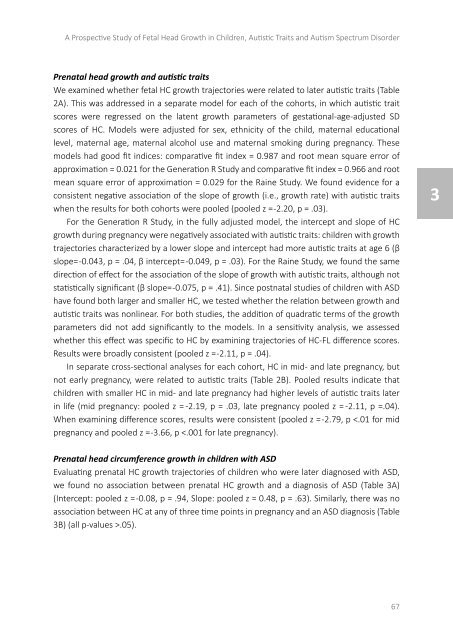On the Spectrum
2lm5UyR
2lm5UyR
Create successful ePaper yourself
Turn your PDF publications into a flip-book with our unique Google optimized e-Paper software.
A Prospective Study of Fetal Head Growth in Children, Autistic Traits and Autism <strong>Spectrum</strong> Disorder<br />
Prenatal head growth and autistic traits<br />
We examined whe<strong>the</strong>r fetal HC growth trajectories were related to later autistic traits (Table<br />
2A). This was addressed in a separate model for each of <strong>the</strong> cohorts, in which autistic trait<br />
scores were regressed on <strong>the</strong> latent growth parameters of gestational-age-adjusted SD<br />
scores of HC. Models were adjusted for sex, ethnicity of <strong>the</strong> child, maternal educational<br />
level, maternal age, maternal alcohol use and maternal smoking during pregnancy. These<br />
models had good fit indices: comparative fit index = 0.987 and root mean square error of<br />
approximation = 0.021 for <strong>the</strong> Generation R Study and comparative fit index = 0.966 and root<br />
mean square error of approximation = 0.029 for <strong>the</strong> Raine Study. We found evidence for a<br />
consistent negative association of <strong>the</strong> slope of growth (i.e., growth rate) with autistic traits<br />
when <strong>the</strong> results for both cohorts were pooled (pooled z = -2.20, p = .03).<br />
For <strong>the</strong> Generation R Study, in <strong>the</strong> fully adjusted model, <strong>the</strong> intercept and slope of HC<br />
growth during pregnancy were negatively associated with autistic traits: children with growth<br />
trajectories characterized by a lower slope and intercept had more autistic traits at age 6 (β<br />
slope= -0.043, p = .04, β intercept= -0.049, p = .03). For <strong>the</strong> Raine Study, we found <strong>the</strong> same<br />
direction of effect for <strong>the</strong> association of <strong>the</strong> slope of growth with autistic traits, although not<br />
statistically significant (β slope= -0.075, p = .41). Since postnatal studies of children with ASD<br />
have found both larger and smaller HC, we tested whe<strong>the</strong>r <strong>the</strong> relation between growth and<br />
autistic traits was nonlinear. For both studies, <strong>the</strong> addition of quadratic terms of <strong>the</strong> growth<br />
parameters did not add significantly to <strong>the</strong> models. In a sensitivity analysis, we assessed<br />
whe<strong>the</strong>r this effect was specific to HC by examining trajectories of HC-FL difference scores.<br />
Results were broadly consistent (pooled z = -2.11, p = .04).<br />
In separate cross-sectional analyses for each cohort, HC in mid- and late pregnancy, but<br />
not early pregnancy, were related to autistic traits (Table 2B). Pooled results indicate that<br />
children with smaller HC in mid- and late pregnancy had higher levels of autistic traits later<br />
in life (mid pregnancy: pooled z = -2.19, p = .03, late pregnancy pooled z = -2.11, p =.04).<br />
When examining difference scores, results were consistent (pooled z = -2.79, p


